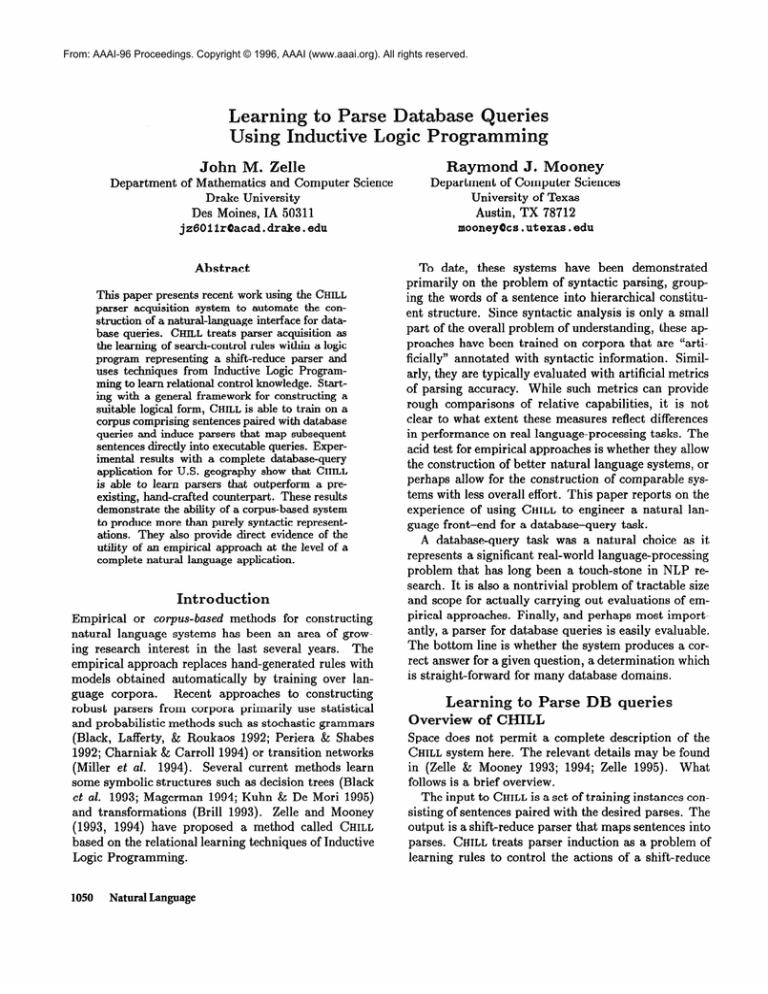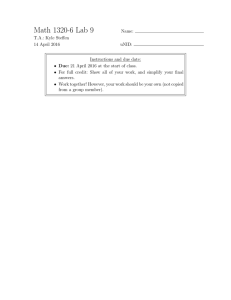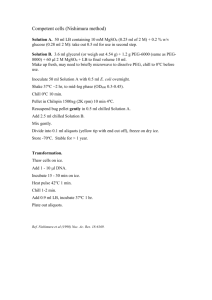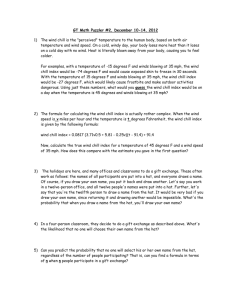
From: AAAI-96 Proceedings. Copyright © 1996, AAAI (www.aaai.org). All rights reserved.
Learning to Parse Database Queries
Using Inductive Logic Programming
John M. Zelle
Department
of Mathematics and Computer Science
Drake University
Des Moines, IA 50311
jz60ilrQacad.drake.edu
Abstract
This paper presents recent work using the CHILL
parser acquisition system to automate the construction of a natural-language interface for database queries. CHILL treats parser acquisition as
the learning of search-control rules within a logic
program representing a shift-reduce parser and
uses techniques from Inductive Logic Programming to learn relational control knowledge. Starting with a general framework for constructing a
suitable logical form, CHILL is able to train on a
corpus comprising sentences paired with database
queries and induce parsers that map subsequent
sentences directly into executable queries. Experimental results with a complete database-query
application for U.S. geography show that CHILL
is able to learn parsers that outperform a preexisting, hand-crafted counterpart. These results
demonstrate the ability of a corpus-based system
to produce more than purely syntactic representations. They also provide direct evidence of the
utility of an empirical approach at the level of a
complete natural language application.
Introduction
Empirical or corpus-based methods for constructing
natural language systems has been an area of growing research interest in the last several years. The
empirical approach replaces hand-generated rules with
models obtained automatically by training over lanRecent approaches to constructing
guage corpora.
robust parsers from corpora primarily use statistical
and probabilistic methods such as stochastic grammars
(Black, Lafferty, & Roukaos 1992; Periera & Shabes
1992; Charniak & Carroll 1994) or transition networks
(Miller et al. 1994). Several current methods learn
some symbolic structures such as decision trees (Black
et al. 1993; Magerman 1994; Kuhn & De Mori 1995)
and transformations
(Brill 1993). Zelle and Mooney
(1993, 1994) h ave proposed a method called CHILL
based on the relational learning techniques of Inductive
Logic Programming.
1050
NaturalLanguage
Raymond
J. Mooney
Department of Computer Sciences
University of Texas
Austin, TX 78712
mooneyQcs.utexas.edu
To date, these systems have been demonstrated
primarily on the problem of syntactic parsing, grouping the words of a sentence into hierarchical constituent structure. Since syntactic analysis is only a small
part of the overall problem of understanding, these ap
proaches have been trained on corpora that are “artificially” annotated with syntactic information. Similarly, they are typically evaluated with artificial metrics
of parsing accuracy. While such metrics can provide
rough comparisons of relative capabilities, it is not
clear to what extent these measures reflect differences
in performance on real language-processing tasks. The
acid test for empirical approaches is whether they allow
the construction of better natural language systems, or
perhaps allow for the construction of comparable systems with less overall effort. This paper reports on the
experience of using CHILL to engineer a natural language front-end for a database-query task.
A database-query task was a natural choice as it
represents a significant real-world language-processing
problem that has long been a touch-stone in NLP research. It is also a nontrivial problem of tractable size
and scope for actually carrying out evaluations of empirical approaches. Finally, and perhaps most importantly, a parser for database queries is easily evaluable.
The bottom line is whether the system produces a correct answer for a given question, a determination which
is straight-forward for many database domains.
Learning
Overview
to Parse DB queries
of CHILL
Space does not permit a complete description of the
CHILL system here. The relevant details may be found
in (Zelle & Mooney 1993; 1994; Zelle 1995).
What
follows is a brief overview.
The input to CHILL is a set of training instances consisting of sentences paired with the desired parses. The
output is a shift-reduce parser that maps sentences into
parses. CHILL treats parser induction as a problem of
learning rules to control the actions of a shift-reduce
parser expressed as a Prolog program. Control-rules
are expressed as definite-clause concept definitions.
These rules are induced using a general concept learning system employing techniques from Inductive Logic
Programming (ILP) a subfield of machine learning that
addresses the problem of learning definite-clause logic
descriptions from examples (Lavraz & Dz’eroski 1994;
Muggleton 1992).
The central insight in CHILL is that the general operators required for a shift-reduce parser to produce
a given set of sentence analyses are directly inferable
from the representations themselves. For example, if
the target is syntactic analysis, the fact the the parser
requires a reduction to combine a determiner and a
noun to form an NP follows directly from the existence
of such an NP in the training examples. However, just
inferring an appropriate set of operators does not produce a correct parser, because more knowledge is required to apply operators accurately during the course
of parsing an example.
The current context of a parse is contained in the
contents of the stack and the remaining input buffer.
CHILL uses parses of the training examples to figure out
the contexts in which each of the inferred operators is
and is not applicable. These contexts are then given to
a general induction algorithm that learns rules to classify the contexts in which each operator should be used.
Since the contexts are arbitrarily-complex parser-states
involving nested (partial) constituents, CHILL employs
an ILP learning algorithm which can deal with structured inputs and produce relational concept descriptions.
Figure 1 shows the basic components of CHILL.
During Parser Operator Generation, the training examples are analyzed to formulate an overly-general
shift-reduce parser that is capable of producing parses
from sentences. The initial parser is overly-general in
that it produces a great many spurious analyses for
any given input sentence. In Example Analysis, the
training examples are parsed using the overly-general
parser to extract contexts in which the various parsing
operators should and should not be employed. ControlRule Induction then employs a general ILP algorithm
to learn rules that characterize these contexts. Finally,
“folds” the learned controlProgram Specialization
rules back into the overly-general parser to produce the
final parser.
Previous experiments have evaluated CHILL'S performance in learning parsers to perform case-role parsing (Zelle & Mooney 1993) and syntactic parsers for
portions of the ATIS corpus (Zelle & Mooney 1994;
1996).
These experiments have demonstrated that
CHILL works as well or better than neural-network or
Control
Exampks
I
Figure 1: The CHILL Architecture
statistical
approaches on comparable corpora.
Parsing DB Queries
Overview of the Problem
For the database-query
task, the input to CHILL consists of sentences paired
with executable database queries.
The query language considered here is a logical form similar to
the types of meaning representation
typically produced by logic grammars (Warren & Pereira 1982;
Abramson 8z Dahl 1989). The semantics of the representation is grounded in a query interpreter that executes queries and retrieves relevant information from
the database. The choice of a logical query language
rather than the more ubiquitous SQL was made because
the former provides a more straight-forward, compositional mapping from natural language utterances-a
property that is necessary for the CHILL approach.
The process of translating from an unambiguous logical
form into other query formats is easily automated.
The domain of the chosen database is United States
geography. The choice was motivated by the availability of an existing natural language interface for a simple
geography database. This system, called Geobase was
supplied as an example application with a commercial
Prolog available for PCs, specifically Turbo Prolog 2.0
(Borland International 1988). Having such an example
provides a database already coded in Prolog for which
a front-end can be built; it also serves as a convenient
benchmark against which CHILL'S performance can be
compared.
Learning
1051
What is the capital of the state with the largest population?
answer(C, (capital (S ,C) , largest (P, (state 6) ,
population(S,P))))).
What are the major cities in Kansas?
answer(C, (major(C), city(C),
loc(C,S),
equal(S,stateid(kansas)
1)).
Figure 2: Sample Database Queries
The Geobase data contains about 800 Prolog facts
asserting relational tables for basic information about
U.S. states, including: population, area, capital city,
neighboring states, major rivers, major cities, and
highest and lowest points along with their elevation.
Figure 2 shows some sample questions and associated
query representations.
Development of the database application required
work on two components:
a framework for parsing
into the logical query representations, and a specific
query language for the geography database. The first
component is domain-independent and consists of algorithms for parsing operator generation and example
analysis to infer the required operators and parse the
training examples. The resulting parsing framework is
quite general and could be used to generate parsers for
a wide range of logic-based representations.
The second component, which is domain specific, is
a query language having a vocabulary sufficient for expressing interesting questions about geography. The
database application itself comprises a parser produced
by CHILL coupled with an interpreter for the query
language. The specific query language for these experiments (hereafter referred to as Geoquery) was initially
developed by considering a sample of 50 sentences. A
simple query interpreter was developed concurrently
with the query language,thus insuring that the rep
resentations were grounded in the database-query task.
The Query Language,
Geoquery
The query language considered here is basically a first-order logical
form augmented with some higher-order predicates or
meta-predicates,
for handling issues such as quantification over implicit sets. This general form of representation is useful for many language processing tasks. The
particular constructs of Geoquery, however, were not
designed around any notion of appropriateness for rep
resentation of natural language in general, but rather
as a direct method of compositionally translating English sentences into unambiguous, logic-oriented database queries.
The most basic constructs of the query representation are the terms used to represent the objects referenced in the database and the basic relations between
them. The basic forms are listed in Figure 3. The
1052
NaturalLanguage
Type
country
city
state
river
place
Form
countryid(Name)
cityid(Name, State)
stateidclame)
riverid(Name)
placeid(Name)
Figure 3: Basic Objects
Example
countryid(usa)
cityid(austin,tx)
stateidctexas)
riverid(colorado1
placeidcpacif ic)
in Geoquery
objects of interest are states, cities, rivers and places
(either a high-point of low-point of a state).
Cities
are represented using a two argument term with the
second argument containing the abbreviation of the
state. This is done to insure uniqueness, since different states may have cities of the same name (e.g.
cityid(columbus,oh) vs. cityid(columbus,ga)).
This convention also allows a natural form for expressing partial information; a city known only by name is
given an uninstantiated variable for its second term.
Form
capital(C)
city(C)
major(X)
place (PI
river(R)
state 6)
capital(C)
area6 ,A)
capital (S ,C)
equal (V , C)
density(S,D)
elevation(P,E)
high-point (S ,P)
higher(Pl,P2)
loc(X,Y)
low-point (S ,P)
len(R,L)
next-to 61 ,S2)
size(X,Y)
traverse (R, S)
Predicate
C is a capital (city).
C is a city.
X is major.
P is a place.
R is a river.
S is a state.
C is a capital (city).
The area of S is A.
The capital of S is C.
variable V is ground term C.
The (population) density of S is P
The elevationof P is E.
The highest point of S is P.
Pl’s elevationis greater than P2’s.
X is located in Y.
The lowest point of S is P.
The length of R is L.
Sl is next to S2.
The size of X is Y.
R traverses S.
Figure 4: Basic Predicates
in Geoquery
The basic relations are shown in Figure 4. The
equal/2 predicate is used to indicate that a certain variable is bound to a ground term representing an object
in the database. For example, a phrase like “the cap
italofTexas”
translates to (capital(S,C), equal@,
stateid(texas)
)) rather than the more traditional
capital(stateid(texas)
,C). The use of equal allows objects to be introduced at the point where they
are actually named in the sentence.
Although the basic predicates provide most of the expressiveness of Geoquery, meta-predicates are required
to form complete queries. A list of the implemented
meta-predicates is shown in Figure 5. These predicates
Form
answer (V , Goal)
largest (V, Goal)
smallest (V ,Goal)
highest (V ,Goal)
lowest (V ,Goal)
longest (V , Goal)
shortest(V,Goal)
c0udD,God,C)
most (X,D,Goal)
fewest (X,D,Goal)
Figure
Explanation
V is the variable of interest in Goal.
Goal produces only the solution
that maximizes the size of V
Analogous to largest.
Like largest
(with elevation).
Analogous to highest.
Like largest (with length).
Analogous to longest.
c is count of unique bindings for D
that satisfy Goal.
Goal produces only the X
that maximizes the count of D
Analogous to most.
5: Meta-Predicates
in Geoquery
are distinguished in that they take completely-formed
conjunctive goals as one of their arguments. The most
important
of the meta-predicates
is answer/S.
This
predicate serves as a “wrapper” for query goals indicating the variable whose binding is of interest (i.e. answers the question posed). The other meta-predicates
provide for the quantification over and selection of extremal elements from implicit sets.
A Parsing Framework for Queries
Although the
logical representations of Geoquery look very different from parse-trees or case-structures on which CHILL
has been previously demonstrated, they are amenable
to the same general parsing scheme as that used for
the shallower representations. Adapting CHILL to work
with this representation requires only the identification
and implementation of suitable operators for the construction of Geoquery-style analyses.
The parser is implemented by translating parsing actions into operator clauses for a shift-reduce parser.
The construction of logical queries involves three different types of operators. Initially, a word or phrase
at the front of the input buffer suggests that a certain structure should be part of the result. The ap
propriate structure is pushed onto the stack. For example, the word “capital” might cause the capital/2
predicate to be pushed on the stack. This type of op
eration is performed by an introduce
operator. Initially, such structures are introduced with new (not coreferenced) variables. These variables may be unified
with variables appearing in other stack items through
a co-reference
operator. For example, the first argument of the capital/2
structure may be unified with
the argument
of a previously
introduced
state/
I pre-
dicate. Finally, a stack item may be embedded into
the argument of another stack item to form conjunctive goals inside of meta-predicates; this is performed
by a conjoin operation.
For each class of operator, the overly-general op
erators required to parse any given example may be
easily inferred. The necessary introduce
operators
are determined by examining what structures occur
in the given query and which words that can introduce those structures appear in the training sentence.
Co-reference
operators are constructed by finding the
shared variables in the training queries; each sharing requires an appropriate operator instance.
Finally, con join operations are indicated by the termembedding exhibited in the training examples.
It is
important to note that only the operator generation
phase of CHILL is modified to work with this representation; the control-rule learning component remains
unchanged.
As an example of operator generation, the first
query in Figure 2 gives rise to four introduce
oper“state” introators: “capital” introduces capital/a,
duces state/i,
“largest” introduces largest/2
and
“population” introduces populat iox&.
The initial
parser-state has answer/2 on the stack, so its introduction is not required. The example generates four
co-reference
operators for the variables (e.g., when
capital/2
is on the top of the stack, its second argument may be unified with the first argument of
answer/Z, which is below it). Finally, the example
produces four conjoin operators.
When largest/2
is on the top of the stack, state/i
is “lifted” into the
second argument position from its position below in the
stack. Conversely, when population/2
is on the top of
the stack, it is “dropped” into the second argument of
largest/2
to form the conjunction. Similar operators
embed capital/2
and largest/2
into the conjunction
that is the second argument of answer/Z.
Experimental
Results
Experiments
A corpus of 250 sentences was gathered by submitting
a questionnaire to 50 uninformed subjects. For evaluation purposes, the corpus was split into training sets of
225 examples with the remaining 25 held-out for testing. CHILL was run using default values for various
parameters.
Testing employed the most stringent standard for accuracy, namely whether the application produced the
correct
answer to a question.
Each
test sentence
was
parsed to produce a query. This query was then executed to extract an answer from the database. The
extracted
answer
was then compared
to the answer
produced by the correct query associated with the test
sentence.
Identical
answers
were scored
as a correct
parsing, any discrepancy resulted in a failure. Figure 6
shows the average accuracy of CHILL’S parsers over 10
Learning
1053
ably does not represent a state-of-the-art standard for
natural language database query systems, neither is it a
“straw man.” Geobase uses a semantics-based parser
which scans for words corresponding to the entities and
relationships encoded in the database. Rather than relying on extensive syntactic analysis, the system attempts to match sequences of entities and associations
in sentences with an entity-association network describing the schemas present in the database. The result is a
relatively robust parser, since many words can simply
be ignored. That CHILL performs better after training
on a relatively small corpus is an encouraging result.
Related
Figure 6: Geoquery:
Accuracy
trials using different random splits of training and testing data. The line labeled “Geobase” shows the average
accuracy of the Geobase system on these 10 testing sets
of 25 sentences. The curves show that CHILL outperforms the existing system when trained on 175 or more
examples.
In the best trial, CHILL's induced parser
comprising 1100 lines of Prolog code achieved 84% accuracy in answering novel queries.
In this application, it is important to distinguish
between two modes of failure. The system could either
fail to parse a sentence entirely, or it could produce a
query which retrieves an incorrect answer. The parsers
learned by CHILL for Geoquery produced few spurious parses. At 175 training examples, CHILL produced
3.2% spurious parses, dropping to 2.3% at 200 examples. This compares favorably with the 3.8% rate
for Geobase.
Discussion
These results are interesting in two ways. First, they
show the ability of CHILL to learn parsers that map
sentences into queries without intermediate syntactic
parsing or annotation. This is an important consideration for empirical systems that seek to reduce the linguistic expertise needed to construct NLP applications.
Annotating corpora with useful final representations is
a much easier task than providing detailed linguistic
annotations. One can even imagine the construction of
suitable corpora occurring as a natural side-effect of attempting to automate processes that are currently done
manually (e.g. collecting examples of the queries produced by database users in the normal course of their
work).
Second, the results demonstrate the utility of an empirical approach at the level of a complete naturallanguage application. While the Geobase system prob1054
Natural Language
Work
As noted in the introduction, most work on corpusbased parsing has focused on the problem of syntactic analysis rather than semantic interpretation.
However, a number of groups participating in the
ARPA-sponsored ATIS benchmark for speech understanding have used learned rules to perform some
semantic interpretation.
The Chronus system from
AT&T (Pieraccini et al. 1992) used an approach based
on stochastic grammars.
Another approach employing statistical techniques is the Hidden Understanding
Models of Miller, et. al. (1994). Kuhn and De Mori
(1995) have investigated an approach utilizing semantic
classification trees, a variation on decision trees familiar in machine learning.
These approaches differ from work reported here in
that learning was used in only a one component of a
larger hand-crafted grammar. The ATIS benchmark
is not an ideal setting for the evaluation of empirical
components per se, as overall performance may be significantly affected by the performance of other components in the system. Additionally, the hand-crafted
portions of these systems encompassed elements that
were part of the learning task for CHILL. CHILL learns
to map from strings of words directly into query representations without any intermediate analysis; thus, it
essentially automates construction of virtually the entire linguistic component. We also believe that CHILL'S
relational learning algorithms make the approach more
flexible, as evidenced by the range of representations
for which CHILL has successfully learned parsers. Objective comparison of various approaches to empirical
NLP is an important area for future research.
Future Work
and Conclusions
Clearly, there are many open questions regarding the
practicality of using CHILL for the development of NLP
systems. Experiments with larger corpora and other
domains are indicated. Another interesting avenue of
investigation is the extent to which performance can
be improved by corpus “manufacturing.”
Since an initial corpus must be annotated by hand, one method
of increasing the regularity in the training corpus (and
hence the generality of the resulting parser) would be
to allow the annotat0.r to introduce related sentences.
Although this approach would require extra effort from
the annotator, it would be far easier than annotating an
equal number of random sentences and might produce
better results.
The development
of automated techniques for lexicon construction
could also broaden the applicability
of CHILL. Currently, the generation of introduce
operators relies on a hand-built lexicon indicating which
Thompson
words can introduce various predicates.
(1995) has demonstrated
an initial approach to corpus-
based acquisition of lexical mapping rules suitable for
use with CHILL-Style
parser acquisition systems.
We have described a framework using ILP to learn
parsers that map sentences into database queries using a training corpus of sentences paired with queries.
This method has been implemented in the CHILL system, which treats parser acquisition as the learning of
search-control
rules within a logic program representExperimental results with
ing a shift-reduce parser.
a complete application for answering questions about
U.S. geography show that CHILL'sparsers outperform
a pre-existing hand-crafted counterpart. These results
demonstrate
CHILL's ability to learn semantic map
pings and the utility of an empirical approach at the
level of a complete natural-language
application.
We
hope these experiments will stimulate further research
in corpus-based
techniques that employ ILP.
Acknowledgments
Kuhn, R., and De Mori, R. 1995.The application of semantic classification trees to natural language understanding. IEEE Transactions on Pattern Analysis and Machine
Intelligence 17(5):449-460.
Lavrae, N., and Dzeroski, S., eds. 1994. Inductive Logic
Ellis HorTechniques and Applications.
Programming:
wood.
Magerman, D. M. 1994. Natrual Lagnuage Parsing as
Statistical Pattern Recognition. Ph.D. Dissertation, Stanford University.
Miller, S.; Bobrow, R.; Ingria, R.; and Schwartz, R. 1994.
Hidden understanding models of natural language. In Proceedings of the 3Znd Annual Meeting of the Association for
Computational Linguistics, 25-32.
Muggleton, S. H., ed. 1992. Inductive Logic Programming.
New York, NY: Academic Press.
Periera, F., and Shabes, Y. 1992.Inside-outside reestimation from partially bracketed corpora. In Proceedings of
the 30th Annual Meeting of the Association for Computational Linguistics, 128-135.
Pieraccini, R.; Tzoukermann, E.; Z. Gorelov, J. L. G.;
Levin, E.; Lee, C. H.; and Wilpon, J. 1992. A speech
understanding system based on statistical representation
of semantics. In Proceedings ICASSP 92. 1-193-I-196.
Thompson, C. A. 1995. Acquisition of a lexicon from
semantic representations of sentences. In Proceeding of
the 33rd Annual Meeting of the Association for Computational Linguistics, 335-337.
Warren, D. H. D., and Pereira, F. C. N. 1982. An efficient
easily adaptable system for interpreting natural language
queries. American Journal of Computational
Linguistics
8(3-4):110-122.
Portions of this research were supported by the National
Science Foundation under grantIRI-9310819.
References
Abramson, H., and Dal& V. 1989.Logic Grammars.
York: Springer-Verlag.
Char&&, E., and Carroll, G. 1994. Context-sensitive
statistics for improved grammatical language models. In
Proceedings of the Twelfth National Conference on Art@cial Intelligence.
New
Black, E.; JeIineck, F.; Lafferty, J.; Magerman, D.; Mercer, R.; and Roukos, S. 1993. Towards history-based
grammars: Using richer models for probabilistic parsing.
In Proceedings of the 31st Annual Meeting of the Association for Computational
Linguistics, 31-37.
Black, E.; Lafferty, J.; and Roukaos, S. 1992. Development and evaluation of a broad-coverage probabiIistic
grammar of English-language computer manuals. In Proceedings of the 30th Annual Meeting of the Association for
Computational
Linguistics, 185-192.
Borland International. 1988. Turbo Prolog 2.0 Reference
Guide. Scotts Valley, CA: Borland International.
Zelle, J. M., and Mooney, R. J. 1993. Learning semantic
grammars with constructive inductive logic programming.
In Proceedings of the Eleventh National Conference on Artificial Intelligence, 817-822.
Zelle, J. M., and Mooney, R. J. 1994. Inducing deterministic Prolog parsers from treebanks: A machine learning
approach. In Proceedings of the Twelfth National Conference on Artificial Intelligence, 748-753.
Zelle, J., and Mooney, R. 1996. Comparative results on
using inductive logic programming for corpus-based parser
construction. In Wermter, S.; Riloff, E.; and Scheler, G.,
eds., Symbolic, Connectionist,
and Statistical Approaches
to Learning for Natural Language Processing. Springer
Verlag.
ZeIle, J. M. 1995. Using Inductive Logic Programming
to Automate the Construction
of Natural Language Parsers. Ph.D. Dissertation, University of Texas, Austin, TX.
available via http:// cs.utexas.edu/users/ml.
BriII, E. 1993. Automatic grammar induction and parsing
free text: A transformation-based approach. In Proceedings of the 31st Annual Meeting of the Association for
Computational
Linguistics, 259-265.
Learning
1055







